If you’ve ever wondered who’s at fault when a cyclist collides with a pedestrian in Indiana, you’re not alone. Many people, both cyclists and those on foot, aren’t completely clear on how the law handles these situations. Understanding who may be held liable is important because both riders and pedestrians have rights and duties when sharing the road.
Cyclists Must Follow the Same Rules as Motor Vehicles
In Indiana, cyclists are treated like any other vehicle when it comes to road rules. This means cyclists have both the right to be on most public roads and the duty to follow the same traffic laws as drivers, such as stopping at stop signs, yielding where required, and riding in the same direction as traffic.
- Sec. 2. A person riding a bicycle or operating a motor driven cycle upon a roadway has all the rights and duties under this article that are applicable to a person who drives a vehicle, except the following:
Cyclists must also use hand signals to indicate turns or stops and keep to bike lanes when available and safe to do so.

Your Case Will Get
The Attention It Deserves

Pedestrian Rights: Right of Way at Crosswalks and Signals
Indiana law states that drivers must yield the right of way to pedestrians crossing at a marked crosswalk or at an intersection where there’s no traffic signal.
- Sec. 36. Except as provided in IC 9-21-17-8 and IC 9-21-3-7(b)(4)(C), when traffic control signals are not in place or not in operation, a person who drives a vehicle shall yield the right-of-way, slowing down or stopping if necessary to yield, to a pedestrian crossing the roadway within a crosswalk when the pedestrian is upon the half of the roadway upon which the vehicle is traveling or when the pedestrian is approaching closely from the opposite half of the roadway.
If a pedestrian is already in a crosswalk, vehicles must stop – this includes those riding bicycles.
Liability for Accidents Involving Cyclists and Pedestrians – When Can Cyclists Be Liable?
Liability for accidents between cyclists and pedestrians in Indiana often comes down to who acted negligently at the time of the collision. Here are some situations where a cyclist may be held responsible for injuring a pedestrian:
Failing to Yield at a Crosswalk
Cyclists are required to stop for pedestrians in marked crosswalks, just like drivers. If a cyclist rides through a crosswalk without stopping and strikes a person crossing legally, they can be held liable for any injuries.
Ignoring Traffic Signals or Signs
If a cyclist runs a red light or blows through a stop sign and causes a collision with a pedestrian, that is a clear violation of Indiana traffic laws. Breaking these rules puts fault on the cyclist.
Riding Recklessly or Too Fast for Conditions
Cyclists are expected to ride at a safe speed and adjust if sidewalks or shared paths are crowded. If a cyclist is moving too fast or weaving unpredictably and hits someone, they may be found at fault.
Distracted or Impaired Riding
Operating a bike while using a cellphone, wearing headphones, or after consuming alcohol/drugs is dangerous on sidewalks or paths. If a distraction or impairment leads to a crash, the cyclist’s liability greatly increases.
Failing to Use Lights or Signals
Indiana law says cyclists must have lights at night and should use a bell or verbal warning when approaching pedestrians.
- (c) Duty to Yield and Signal. Whenever a person is riding a Bicycle upon a Multi-Use Path or Sidewalk, such person shall yield the right-of-way to any person they approach from behind and shall give an audible signal before overtaking and then safely passing such person.
If a cyclist fails to give a proper warning or is hard to see and hits a pedestrian, they may be responsible for resulting injuries.
In all these situations, when a cyclist doesn’t meet their legal obligations or acts without reasonable care, they can be held liable for damages and injuries caused to pedestrians.



Comparative Negligence in Indiana – Pedestrian is Partially Responsible For Accident
Indiana uses a modified comparative negligent system for accidents, including those involving cyclists and pedestrians. This means that more than one person can share the blame for a crash, so both the cyclist and pedestrian might each be partially at fault.
If a pedestrian is found to be responsible for part of the bicycle accident, such as not paying attention or jaywalking, they can still recover compensation for their injuries as long as their share of the fault is 50% or less.
- Sec. 6.
- (a) In an action based on fault that is brought against:
- (1) one (1) defendant; or
- (2) two (2) or more defendants who may be treated as a single party; the claimant is barred from recovery if the claimant’s contributory fault is greater than the fault of all persons whose fault proximately contributed to the claimant’s damages.
- (b) In an action based on fault that is brought against two (2) or more defendants, the claimant is barred from recovery if the claimant’s contributory fault is greater than the fault of all persons whose fault proximately contributed to the claimant’s damages.
- (a) In an action based on fault that is brought against:
However, whatever percentage of fault the pedestrian is assigned will reduce the amount of money they can receive.
For example, if a pedestrian is found to be 30% at fault, any settlement or verdict will be reduced by 30%. If the pedestrian is 51% or more to blame, Indiana law bars them from recovering any damages for the accident. This system encourages everyone to pay attention and follow the law at all times.
Understanding who is responsible after a cyclist hits a pedestrian in Indiana can be complicated and depends on the details of the accident. Both cyclists and pedestrians have important rights and responsibilities when sharing the road. If you or a loved one has been involved in an accident with a pedestrian or cyclist, talking with an attorney is the best way to figure out what you could be entitled to. Contact us today to schedule a free consultation.




